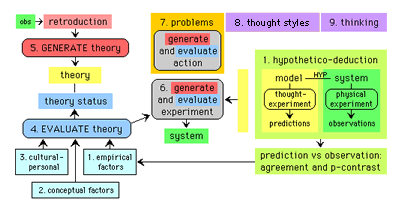Using Scientific Method (and Design Method) for Education
by Craig Rusbult, Ph.D.
As explained in Scientific Method - My Personal History, for a long time I've been fascinated by scientific methods of thinking and their integration into a coherent Scientific Method.
For awhile, in 2011-2012, this page was one section in a larger page about Teaching Scientific Methods of Thinking in Science Labs.
Does a method really exist ? Without doubt, some scientific methods of thinking are commonly used by scientists. And even though no single “scientific method” is used by all scientists in all areas of science at all times, I have developed a model of science that accurately describes the flexible improvisation typically used by scientists during their process of trying to ask-and-answer questions about nature. Because my model of scientific method shows the working relationships between 9 aspects of science — 3 for evaluation criteria (empirical, conceptual, cultural-personal), 3 for the design (the generation & evaluation) of theories and experiments, 3 for the process of science (problem-solving projects, thought styles, productive thinking) — by logically integrating them into a coherent framework, I call it Integrated Scientific Method. This model is summarized (with links to related ideas) in An Introduction to Scientific Method and the 9 aspects of science are outlined in Scientific Method - An Overview and with more depth in Scientific Method - A Detailed Overview which condenses ideas from my two-part doctoral dissertation. |
|
 |
I also have developed a model of Integrated Design Method to describe the
flexible goal-directed improvising of designers during the problem-solving process of design. This model — in which ideas are creatively generated, and are critically evaluated by comparing Goals, Predictions, and Observations in 3 ways to produce Quality Checks and Reality Checks — is outlined in An Introduction to Design and (using 9 modes of thinking-and-action) An Overview of Design Method. Applications for Education My models of design & science are intended to achieve two main goals: A) be an accurate description of methods, of what designers & scientists think-and-do when they are solving problems & seeking knowledge, thus improving our UNDERSTANDING of design & science; B) help students understand design & science, and increase the quality of their own thinking skills by helping them master the methods of thinking used by designers & scientists, thus improving our TEACHING. Let's look at the second goal: How can these models be used for education? |
 |
Scientific Method also can be useful in K-12 education, and both methods (for design and science) can be useful in college education. But for various reasons (explained in Curriculum Design using Design-and-Science for “Thinking Skills” Education) it's easier to use Design Method (compared with Scientific Method) for instruction in K-12, and in college it's more difficult (compared with K-12) to use either Design Method or Scientific Method for instruction. But in college both methods can be used indirectly by teaching their component parts, which are the thinking activities used by designers and scientists, and then connecting these to thinking methods.
For example, Hypothetico-Deductive Logic (it's one goal used in a table to illustrate goals-and-activities) is the essence of Empirical Factors in Theory Evaluation, which is one of the 9 aspects of science in my model of Integrated Scientific Method. Another aspect of science, Designing Experiments, is also in the table of activities-and-goals, and all other aspects of science can also be included. And so can many sub-aspects (these are thinking activities within the major aspects), including all other goals in the table (Observation-Based Logic, Calibration Logic,... Does it matter?) and more. Occasionally, after students do activities a teacher can ask "why is this important for science?" and help students understand how their actions fit into the big picture of Scientific Method, how individual thinking skills perform a useful function in the coordinated thinking process of science, whose ultimate goal is to seek answers for questions about nature.
And the basic strategy of science, like the strategies for design, are used by students in everyday life. The logical foundation of Scientific Method is not strange and mysterious; it's a thinking strategy we often use in everyday life when we do reality checks by comparing theory-based predictions with reality-based observations, to determine how closely our theories about “the way the world is” match “the way the world really is.” Then, building on this simple foundation, we (teachers and students) can move onward to explore the fascinating complexity of scientific methods.
Scientific Thinking Skills (and Methods) for Teachers
Two types of lab teachers can improve the quality of their own thinking while they are teaching skills-and-methods to students:
In K-12 schools and small colleges, usually labs are taught by course instructors with long-term careers in teaching, and their teaching skill will improve when thinking skills education for students also helps the teachers become better thinkers.
In large research universities, most labs for the core sciences (biology, chemistry, physics) are taught by Teaching Assistants who are graduate students. As
students, usually their main goal
is
learning
how
to become
skilled scientists in research labs, and getting a degree to validate their skills. If labs are well designed, their teaching experience will help them achieve their goal of improved research skills, because an indirect educational benefit of teaching is that while these grad students are helping undergrad students learn skills-and-methods in labs, they will be improving their
own thinking skills and knowledge of scientific methods.